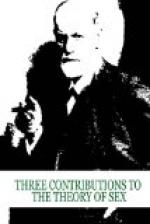Results of Psychoanalysis.—In this manner it has been discovered that the symptoms represent the equivalent for the strivings which received their strength from the source of the sexual impulse. This fully concurs with what we know of the character of hysterics, which we have taken as models for all psycho-neurotics, before they have become diseased, and with what we know concerning the causes of the disease. The hysterical character evinces a part of sexual repression which reaches beyond the normal limits, an exaggeration of the resistances against the sexual impulse which we know as shame and loathing. It is an instinctive flight from intellectual occupation with the sexual problem, the consequence of which in pronounced cases is a complete sexual ignorance, which is preserved till the age of sexual maturity is attained.[24]
This feature, so characteristic of hysteria, is not seldom concealed in crude observation by the existence of the second constitutional factor of hysteria, namely, the enormous development of the sexual craving. But the psychological analysis will always reveal it and solves the very contradictory enigma of hysteria by proving the existence of the contrasting pair, an immense sexual desire and a very exaggerated sexual rejection.
The provocation of the disease in hysterically predisposed persons is brought about if in consequence of their progressive maturity or external conditions of life they are earnestly confronted with the real sexual demand. Between the pressure of the craving and the opposition of the sexual rejection an outlet for the disease results, which does not remove the conflict but seeks to elude it by transforming the libidinous strivings into symptoms. It is an exception only in appearance if a hysterical person, say a man, becomes subject to some banal emotional disturbance, to a conflict in the center of which there is no sexual interest. Psychoanalysis will regularly show that it is the sexual components of the conflict which make the disease possible by withdrawing the psychic processes from normal adjustment.
Neurosis and Perversion.—A great part of the opposition to my assertion is explained by the fact that the sexuality from which I deduce the psychoneurotic symptoms is thought of as coincident with the normal sexual impulse. But psychoanalysis teaches us better than this. It shows that the symptoms do not by any means result at the expense only of the so called normal sexual impulse (at least not exclusively or preponderately), but they represent the converted expression of impulses which in a broader sense might be designated as perverse if they could manifest themselves directly in phantasies and acts without deviating from consciousness. The symptoms are therefore partially formed at the cost of abnormal sexuality. The neurosis is, so to say, the negative of the perversion.[25]




